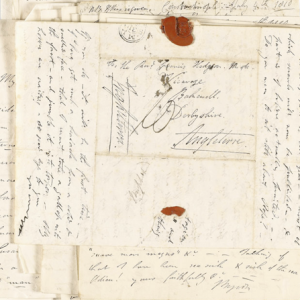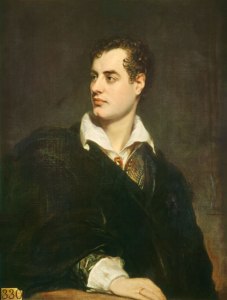 Out of all the manuscripts contained within a literary archive, authors’ letters perhaps promise the most naked insight into the mind of the artist. Quite often, these letters are intimate, confessional, the authors’ naked voices so different to published material or interviews where, knowing their words will be seen by a larger audience, they are on their best behaviour. This appearance of intimacy can be intoxicating for the researcher. It can often feel like eavesdropping on a private conversation, discovering an author’s unabridged opinions on everything from writing, to book, to political insights, as well as the tantalising pieces of gossipy trivia that reveal the author’s life, loves and more. But literary letters are much more complex documents than this sense of guard-down intimacy indicates. It is well known that the Romantic Poets would correspond with each other frequently, and many of these letter have become famous in their own right:
Out of all the manuscripts contained within a literary archive, authors’ letters perhaps promise the most naked insight into the mind of the artist. Quite often, these letters are intimate, confessional, the authors’ naked voices so different to published material or interviews where, knowing their words will be seen by a larger audience, they are on their best behaviour. This appearance of intimacy can be intoxicating for the researcher. It can often feel like eavesdropping on a private conversation, discovering an author’s unabridged opinions on everything from writing, to book, to political insights, as well as the tantalising pieces of gossipy trivia that reveal the author’s life, loves and more. But literary letters are much more complex documents than this sense of guard-down intimacy indicates. It is well known that the Romantic Poets would correspond with each other frequently, and many of these letter have become famous in their own right:
Wordsworth’s Goslar Letter in the archives of the Wordsworth Trust; John Keats’s contentious letters to Fanny Brawne; or Lord Byron’s many love letters. However, thinking of these letters as pure and intimate windows into the minds of their authors is too simplistic. There are often many forces that change the way a letter is written and that prevent the missives from being completely free in what they have to say. As Liz Stanley writes, ‘Letters traverse private and public, having the qualities of both and occupying a “middle space” in which “private” letters may be written and read in public situations’. The letter writer is aware of audience, both intended and otherwise, and may go some way to manage the information contained within the letter. In other words, a letter, whether intended to be private or not, can easily fall into the hands of those to which it was not addressed.
 Today we might think of governmental powers such as the Patriot Act in the United States and the GCHQ scandal in the UK as regulatory forces on the writing of digital content, whether private emails or messages on social media. Yet, we technologically adept moderners are not the only generation to be pestered by governmental snooping. When the Romantic Poets were writing to each other, they were aware of governmental powers to seize and open letters while they were in the hands of the post office. In striking similarities to something like the Patriot Act, the Traitorious Correspondence Act of 1793 (largely a response to the French Revolution) gave the government the power to ‘scrutinize, appropriate, or redact any written material circulating in and out of England’. People using the post office were well aware of this, and it is likely that they altered what they wrote in their letters just in case they were read by an unintended person. Even before the Traitorious Correspondence Act, there is evidence that noted letter writers were altering their letters to avoid incriminating themselves. In 1732, John Gay wrote to Jonathan Swift: ‘If I do not write intelligibly to you, it is because I would not have the clerks of the post office know everything I am doing’.
Today we might think of governmental powers such as the Patriot Act in the United States and the GCHQ scandal in the UK as regulatory forces on the writing of digital content, whether private emails or messages on social media. Yet, we technologically adept moderners are not the only generation to be pestered by governmental snooping. When the Romantic Poets were writing to each other, they were aware of governmental powers to seize and open letters while they were in the hands of the post office. In striking similarities to something like the Patriot Act, the Traitorious Correspondence Act of 1793 (largely a response to the French Revolution) gave the government the power to ‘scrutinize, appropriate, or redact any written material circulating in and out of England’. People using the post office were well aware of this, and it is likely that they altered what they wrote in their letters just in case they were read by an unintended person. Even before the Traitorious Correspondence Act, there is evidence that noted letter writers were altering their letters to avoid incriminating themselves. In 1732, John Gay wrote to Jonathan Swift: ‘If I do not write intelligibly to you, it is because I would not have the clerks of the post office know everything I am doing’.
When coming to research literary correspondence, there are several other complicating factors that obscure the idea that letters hold intimate and private thoughts. Archives in general are incomplete sites of knowledge, the letters they contain more so. Often, there is only one side of the correspondence (see the correspondence in the Don DeLillo archive at the Harry Ransom Center where DeLillo’s responses to the letters are largely absent). This influences the understanding of the letters as they do not represent the whole picture of a conversation. The contexts in which the letters are written are often lost to time: was the writer drunk? Was he angry, or jovial? This can’t be known and as such interpreting the tone of the words is usually guesswork. It is also difficult to tell, certainly in the case of modern typed letters, how much thought has been put into composing the letter, whether the author has written it quickly and carelessly or it has gone through several drafts. It is important to consider the construction of the archive: why has the author kept these specific letters? As Nichola Deane writes, ‘recipients save letters that tell a particular story about themselves’. Whether intentionally or subconsciously, the archive is shaped by the subject.
 The physical nature of the letters cannot be ignored, and examining the paper and handwriting often makes up part of a scholar’s interpretative work. In 1824, Lord Byron’s personal valet, W. Fletcher, wrote to the Hon. Mrs Leigh, informing her of the poet’s death. The letter is stained with what has been chemically proven to be a real human tear, though it is impossible to say whose. The challenge for the scholar is determining how to interpret this single tear-stain within the context of the text of the letter and the circumstances in which it was written and/or read.
The physical nature of the letters cannot be ignored, and examining the paper and handwriting often makes up part of a scholar’s interpretative work. In 1824, Lord Byron’s personal valet, W. Fletcher, wrote to the Hon. Mrs Leigh, informing her of the poet’s death. The letter is stained with what has been chemically proven to be a real human tear, though it is impossible to say whose. The challenge for the scholar is determining how to interpret this single tear-stain within the context of the text of the letter and the circumstances in which it was written and/or read.
With all of these complications and interpretative hurdles, what good is the examination of an archive of literary correspondence? Despite not being fully private documents, letters do reveal the engagement of an author to his peers, or the world around him. They can illuminate the published works by talking candidly about the composition (especially if the correspondence is between the author and an editor), and they can provide valuable context to the author’s creative mind-set. Literary letters will always be the most immediately fascinating manuscripts in an archival collection, perhaps more so because of their complexities and their ability to cross the boundary between an author’s personal and professional lives.